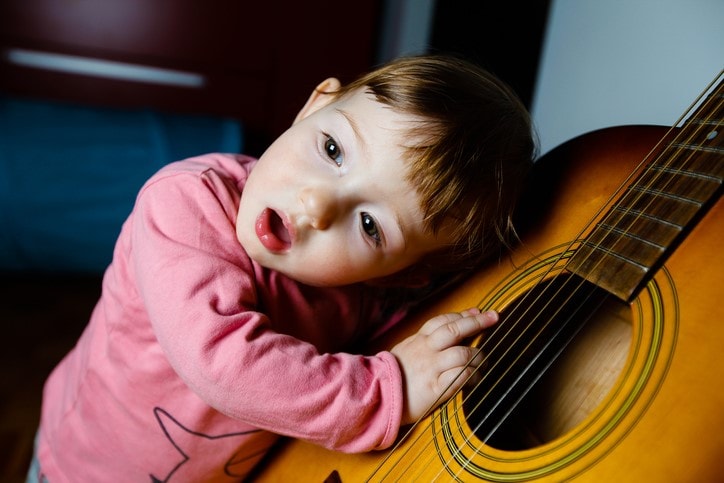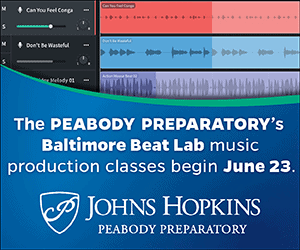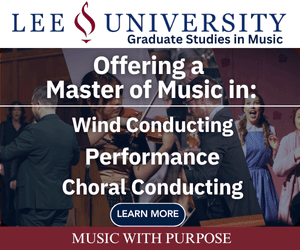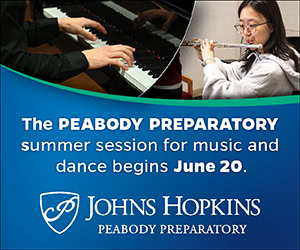/ News Posts / Want Young Children to PLAY Music?
Want Young Children to PLAY Music?
Start by Giving Them Opportunities to Play WITH Music!
By Anne Sailer and Lauren Guilmartin, sponsored by Music Together Worldwide
Twenty-year-old college sophomore Sam was just two when his mom picked up a $5 guitar at a yard sale. She wanted Sam to have a real instrument to see, hear, touch, and explore. It wasn’t until nine years later that Sam started guitar lessons. At the end of the fourth lesson, the teacher said to his mom, “I’ve never had a student learn so much, so fast!” It’s easy to assume that Sam had some kind of “musical gift,” but here’s the truth: While Sam started lessons to learn to PLAY the guitar at eleven, he’d been playing WITH the instrument since age two. That’s when his guitar–learning truly began.
As early childhood education professionals and researchers know, young children practice skills and reinforce their learning through play. (See these articles from National Association for the Education of Young Children for more on play and early learning.) Even before his mom gave him that guitar, Sam’s parents encouraged him to play WITH music. They sang to him, danced around the living room together, and drummed along to the radio. Sam’s music-learning actually began at birth.
“To lay a strong foundation for future music-learning, children ages birth through five need many opportunities for developmentally appropriate, non-performance-oriented music activities that support their innate tendency to play, both at home and at school.”
To lay a strong foundation for future music-learning, children ages birth through five need many opportunities for developmentally appropriate, non-performance-oriented music activities that support their innate tendency to play, both at home and at school. Take Sam: His parents made sure he had lots of chances to play with music. Ideally, his early school experiences included a play-based music education curriculum rooted in the understanding that “music-play” often looks very different than “playing music.”
This approach to teaching young children music incorporates a developmental orientation, where adults model, facilitate, and scaffold a music experience for children, providing a rich variety of musical input and supporting spontaneous musical behaviors—all while giving children the time and space they need to process the music they are hearing and exploring. By contrast, music lessons for older children most often involve an instructional orientation, where students are expected to listen to instructions, follow some pre-set rules, practice, and perform. While this is appropriate for older music students, young children are wired to learn music through a developmental orientation grounded in the understanding that young children teach themselves through play.
While a “music class” in early childhood is often thought of as teacher-led songs (the music teacher in the circle with a guitar), developmentally appropriate music education goes well beyond singing along. It fosters child-initiated music-play and creates a playful music environment that encourages and values children’s own ways of making music; allows each child to take ownership of their music-learning; and affords teachers an opportunity to maximize the learning benefits of play. Children who grow up playing with music in this non-formal way, like Sam, are therefore naturally more prepared when the time comes to start formal music instruction. Through their play, they learned how to “speak” the language of music (as Sam’s guitar teacher noted!).
So, how can we, as music educators, support music-play in an early childhood music education class?
- Provide a child-centered, playful music environment (e.g., offer age-appropriate instruments like egg shakers; sing songs without words; sing silly songs).
- Encourage and value children’s own way to make music, releasing the idea that there is a “right way” to make music (e.g., resist the urge to show a child the “right way” to shake their eggs).
- Allow each child to take ownership over their music-learning (and teach themselves) (e.g., let a child wander around the room, stare out the window, observe quietly, put their ear on the drum, etc.).
- Establish a non-goal-oriented, non-formal setting (e.g., avoid evaluative, performance-based statements like, “You’re such a good drummer!”).
- Observe and reinforce children’s music-play (e.g., notice when a child hums or says a word/sound on the resting tone, and playfully sing it back to them).
- Model playing with music (e.g., make up silly words/vocables to songs; be obviously joyful and playful in class).
Integral to all these examples is a combination of both child-initiated and teacher-led activity and strong environmental support with opportunities for exposure and experimentation. Music at circle time or in a weekly music session provides exposure; spontaneous music-play provides for experimentation; experimentation can eventually lead to mastery. Every time a child revisits a song to play with it, they are in fact learning it—and learning about its musical elements.
Taking this developmental approach toward early childhood music education isn’t necessarily common in our performance-oriented music culture. Yet, given what we know about how young children learn (through play!), supporting them in playing with music is the most developmentally appropriate way to facilitate music-learning in early childhood. It’s also the best way to set them up for success when they one day begin taking lessons to learn how to play music!
About the authors:
 Anne Sailer, M.A., is an early childhood music specialist who develops programs, writes curricula, and leads teacher training workshops for Music Together Worldwide. She works to educate adults in communities around the world on the critical importance of live music-making in early childhood (birth through age 5). Sailer is also a partner in the Montclair Community Pre–K Early Learning Institute, leading S.T.E.A.M. music-in-the-classroom workshops for early childhood educators in the New Jersey, New York, and Connecticut tri-state region.
Anne Sailer, M.A., is an early childhood music specialist who develops programs, writes curricula, and leads teacher training workshops for Music Together Worldwide. She works to educate adults in communities around the world on the critical importance of live music-making in early childhood (birth through age 5). Sailer is also a partner in the Montclair Community Pre–K Early Learning Institute, leading S.T.E.A.M. music-in-the-classroom workshops for early childhood educators in the New Jersey, New York, and Connecticut tri-state region.
Lauren Guilmartin, M.A., is the director of  early learning at Music Together Worldwide, where she oversees the in-school and research departments. Guilmartin manages projects using variations of the Music Together curriculum in a wide variety of early care, education, early intervention, and outreach settings. She frequently presents at education conferences in the United States and abroad. Guilmartin earned her master’s in developmental psychology at Teachers College, Columbia University, with a focus in early childhood development and education.
early learning at Music Together Worldwide, where she oversees the in-school and research departments. Guilmartin manages projects using variations of the Music Together curriculum in a wide variety of early care, education, early intervention, and outreach settings. She frequently presents at education conferences in the United States and abroad. Guilmartin earned her master’s in developmental psychology at Teachers College, Columbia University, with a focus in early childhood development and education.
Interested in reprinting this article? Please review the reprint guidelines.
The National Association for Music Education (NAfME) provides a number of forums for the sharing of information and opinion, including blogs and postings on our website, articles and columns in our magazines and journals, and postings to our Amplify member portal. Unless specifically noted, the views expressed in these media do not necessarily represent the policy or views of the Association, its officers, or its employees.
Catherina Hurlburt, Marketing Communications Manager. April 22, 2020. © National Association for Music Education (NAfME.org)
Published Date
April 22, 2020
Category
- Uncategorized
Copyright
April 22, 2020. © National Association for Music Education (NAfME.org)







